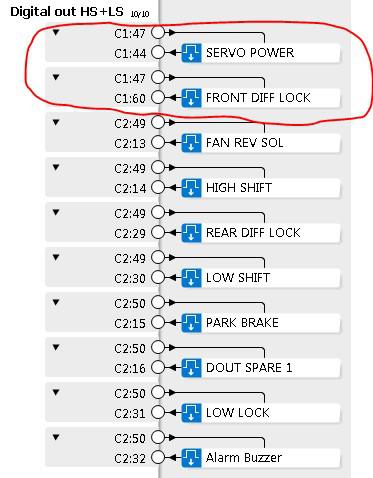
0
Under review
MC43 DOUT HS + LS
Chris Litwin 8 years ago
in Master modules / MC4x
•
updated by Gustav Widén (System support) 8 years ago •
5
We are having some odd things happening with a system designed using DOUT HS + LS outputs.
We will start with the first group circled in Red below, but are having the same issues with the other HS + LS groups. You can also reference the schematic below for the HS + LS wiring for “Servo Power” and Front “Diff Lock”. This is with "DOUT under current detection" on.
- If Servo Power and Front Diff Lock both are False and we disconnect one or the other, the corresponding function will show “open load” as expected.
- If Servo Power is True and Front Diff Lock is False, and we disconnect either one, the corresponding function will show “open load” as expected.
- If Servo Power is False and Front Diff Lock is True and we disconnect Servo Power, no “open load” is shown
- If Servo Power is False and Front Diff Lock is True and we disconnect Front Diff Lock, both show “open load”
- If Servo Power is True and Front Diff Lock is True and we disconnect either one, no “open load” is shown
If we turn "DOUT under current detection" off, the outputs will behave how we understand they are supposed to. Although, doing so removes open load detection when the output is true.


Customer support service by UserEcho

This is not entirely intuitive, it has to do with the undercurrent threshold, and how this is measured.
The MC4x measures undercurrent when the output is on using the highside driver. It is the combined load that is checked for undercurrent. I've tried to describe this in the MC4x manual, in Appendix B
The undercurrent threshold is found in Appendix A, it is ~60 mA. This is what you disable with the property.
Why does it make a difference which function is true and which is false? Shouldn't they behave the same way no matter which is true and false? The other DOUT HS+LS were behaving the same way, where if the first output in the group is true it gives different errors than if say the second output in the group is true.
Case 1:
Case 2:
I updated the picture from the instructions with a more recent version, and highlighted also under current.
It is only when the output is on (DOUT True) that under current is an applicable error. (when the Digital out HS+LS is off, the current sense is used to see that no current goes out, this would result in the overload error as status).
The HS+LS share the current sense, that is the explanation to the comment
*with multiple low sides, open load while on is detected only when combined load is showing undercurrent
I'm still not following. I understand why case 2 is happening, and it makes sense to me, but case 1 should have the same outcomes as case 2. In case 1 both outputs should go open load when servo power is disconnected because the current goes below the threshold, and also when front diff lock is disconnected it should not show open load at all as long as servo power is connected and true.
Thank you for the response.
I looked at it again, and what you are saying does seem strange.
The undercurrent detect should either set open load status on all the channels that share the same high-side pin, or limit this to only the active channel/channels. I think the intended behavior is to hit all channels, but I need to check to be sure.
The part that really seems strange is this one:
This doesn't seem related to undercurrent detect, instead it seems to be something related to the the off-state open load detect.